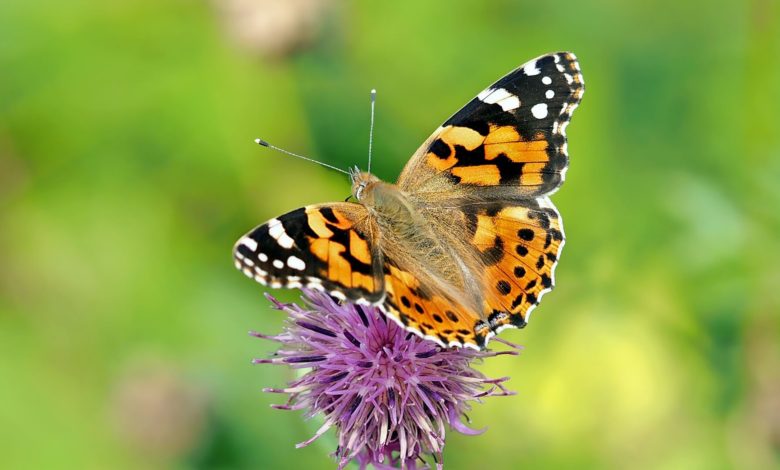What Are The Differences Between Moths And Butterflies?

Butterflies and moths belong to the order of insects, lepidoptera, in the scientific classification. Insects, which are the creatures with the highest number of species, are a group of invertebrates with more than 1,000,000 in number. Their number is increasing with new species added from year to year, it is now accepted that this number reaches 2,000,000. Almost 90% of the animals living in the world are insects and they can be found everywhere. Classification is used by scientists to show how organisms relate to each other and group them according to their characteristics. The scientific classification of butterflies and moths is as follows:
Realm: Animalia (Animals)
Branch (Phylum): Arthropoda (Arthropod)
Class (Clasis): Insecta (Insects)
Order: Lepidoptera (Pulwingers)
Butterflies and moths share the same realm, phylum (branch), class and order (Lepidoptera: scales). The order Lepidoptera has 126 families, 180,000 different species. Approximately 18,000 of these species are butterflies.
The word lepidoptera consists of the words “lepis” meaning scale in Greek and “pteron” meaning wing. Their wings are of two pairs and their size can vary depending on the species of butterfly. Wings are absent in some butterfly species and some females. Looking at the wing of a butterfly or moth under the microscope, thousands of tiny, invisible colored scales lined up like an array of tiles are noticed. When the scales on the wings are shaken or touched, they break off, and they can be spilled on the hands in the form of dust. These structures, called scales, are actually modified bristles whose ends are flattened and expanded. Butterflies and moths have more similarities than powdery scales.
Butterflies and moths that join the same order are divided into families (families) according to their different physical characteristics after this step. Both insects begin their lives as hungry caterpillars before fully transforming into adult flying forms. Both take nectar from the flowers and supplement their nutrition with other liquids, such as mineral-filled still water and the juice of rotting fruit. While these two insect species have a lot in common, there are also many physical and behavioral differences between them. It is usually easy to see the physical differences between them. There are some basic rules that can be followed to distinguish between butterflies and moths, as well as exceptions to these rules.
How to Tell the Difference Between a Butterfly and a Moth?
There are some ways, behavioral and anatomical differences to help identify butterflies and moths. Butterfly and moth distinction can be made by looking at the following criteria:
Becoming Day or Nocturnal: Behaviorally, moths are mostly nocturnal, they fly and feed at night, but there are also moths that are active during the day (such as the magpie moth). On the other hand, butterflies are mostly diurnal, meaning they are active throughout the day. For this reason, the winged insect that appears to feed on a flower on a spring afternoon is most likely a butterfly. However, there are also butterflies that fly at dawn and dusk.
Antenna Structures: One of the easiest ways to tell the difference between a butterfly and a moth is to look at its antennae. If there are enlarged mace-like structures at the ends of their antennae, it is a living butterfly to look at. In contrast, moths’ antennae are tapered to a point and are usually hairy, comb-like in structure. Sometimes they are thin like butterflies antennae, but do not have stick-like extensions at their tips.
Position of Wings During Rest: Butterflies and moths also tend to hold their wings differently when they are resting. At rest, butterflies often fold their wings over their backs, backwards, vertically, and only the lower parts of the wings remain visible. Most moths at rest tend to flatten their wings towards their bodies, spread them sideways, hold their bellies in a tent-like shape that conceals their bellies, and hang down their backs. Thus, only the upper surface of the wings is visible, but some moths keep their wings vertical or angled.
Frenulum: Unlike butterfly wings, moths’ wings have a structure called frenulum that connects the front wing to the rear wing. Thus, the wings can work together in harmony during flight. Butterflies have no frenulum.
Body Size and Colors: Moths are often fat, plump and hairy; butterflies are usually larger, thinner, lighter and smoother. Many butterflies have vibrant, brightly colored markings on the upper side of their wings, but the undersides have paler colors and patterns, which camouflage them well when their wings are closed (folded vertically upwards). Dull, brown butterflies can also be found, although most of them have vibrant colors. Moths usually have dull colored wings. There are also moths that look like a butterfly, brightly colored, colorful and active throughout the day, such as the Madagascar sunset moth and Urania leiluse (Green striped urania).
Pupa Stage: Butterflies and moths reproduce through eggs. It reproduces by laying eggs. After the egg, the larvae (caterpillars) hatch and develop. The larvae turn into pupae. Pupa is the intermediate stage between larva and adulthood. The pupal period passes in a cocoon and when metamorphosis is complete, they eventually mature. Butterflies or moths that emerge from the cocoon cannot fly immediately and can fly after their folded wet wings dry. The pupal stages of butterflies and moths are slightly different. Cocoons and chrysalis are protective covers for the pupa. Both moths and butterflies go through a period of metamorphosis in a chrysalis or protective shell. However, moths often surround their chrysalis (pupae) in cocoons formed of silk, sometimes camouflaging them with leaves or debris. A butterfly makes a chrysalis tough, smooth and without silk cover.
The differences described above make it easier to decide whether an insect is a butterfly or a moth, but not every member of the order Lepidoptera fits exactly into the butterfly and moth categories. There are also butterflies with moth-like qualities and moths with butterfly-like qualities. Hopshoppers have stocky bodies like moths, but their antennae, which usually have a little twist at the tips, resemble those of butterflies. Like butterflies, hops fly during the day, but like moths, they tend to have a paler color. But somehow they are not like butterflies or moths. Hoppers hold their wings at their own angle, with their front wings separate from their rear wings.
Some Facts About Butterflies and Moths
There are many more species of moths than butterflies. Butterflies and hops make up 6 to 11 percent of the order Lepidoptera, while moths make up 89-94 percent of the order Lepidoptera.
If a butterfly’s wing is touched and the dust is rubbed, it is not true that the butterfly cannot fly. The powder is actually very small flakes and a butterfly sheds these scales over its lifetime.
Butterflies and moths are holometabolous, meaning they undergo a complete metamorphosis from eggs to caterpillars and from chrysalis to adults.
The largest butterflies known in the world are the Birdwing butterflies. The butterfly species Queen Alexandra Birdwing (Ornithoptera alexandrae) in the rainforests of Papua New Guinea has a wingspan of approximately 28 cm. It is the rarest of all butterflies. The Goliath birdwing (Ornithoptera goliath) species butterfly, also found in the same rainforests, is the largest butterfly after Queen Alexandra Birdwing, with an average wingspan of 28 cm.
- The smallest known butterflies, Lycaenidae, found in North America and Africa, are water beauties, namely blues. Their wingspan is between 0.635 cm and 1.27 cm. Western Dwarf Blue is the smallest.
- The most common butterfly is the cabbage butterfly found in North America, Africa, Europe Asia, New Zealand Australia, Bermuda, and Hawaii. In New Zealand these are simply called “white butterflies.” What are the Differences between Moths and Butterflies?
- Atlas moths (Saturniidae) are the largest known moths, with a wingspan of 30.48 cm.
- The smallest known moth is in the family of dwarf moths (Nepticulidae) with a wingspan up to 0.238125 cm (3/32 inch).





